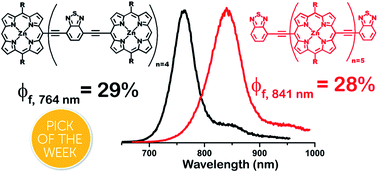Driving high quantum yield NIR emission through proquinoidal linkage motifs in conjugated supermolecular arrays†
Abstract
High quantum yield NIR fluorophores are rare. Factors that drive low emission quantum yields at long wavelength include the facts that radiative rate constants increase proportional to the cube of the emission energy, while nonradiative rate constants increase in an approximately exponentially with decreasing S0–S1 energy gaps (in accordance with the energy gap law). This work demonstrates how the proquinoidal BTD building blocks can be utilized to minimize the extent of excited-state structural relaxation relative to the ground-state conformation in highly conjugated porphyrin oligomers, and shows that 4-ethynylbenzo[c][1,2,5]thiadiazole (E-BTD) units that terminate meso-to-meso ethyne-bridged (porphinato)zinc (PZnn) arrays, and 4,7-diethynylbenzo[c][1,2,5]thiadiazole (E-BTD-E) spacers that are integrated into the backbone of these compositions, elucidate new classes of impressive NIR fluorophores. We report the syntheses, electronic structural properties, and emissive characteristics of neoteric PZn-(BTD-PZn)n, PZn2-(BTD-PZn2)n, and BTD-PZnn-BTD fluorophores. Absolute fluorescence quantum yield (ϕf) measurements, acquired using a calibrated integrating-sphere-based measurement system, demonstrate that these supermolecules display extraordinary ϕf values that range from 10–25% in THF solvent, and between 28–36% in toluene solvent over the 700–900 nm window of the NIR. These studies underscore how the regulation of proquinoidal conjugation motifs can be exploited to drive excited-state dynamical properties important for high quantum yield long-wavelength fluorescence emission.

- This article is part of the themed collections: Papers celebrating the birthday and achievements of Professor Michael Wasielewski, 2020 ChemSci Pick of the Week Collection and 2020 Chemical Science HOT Article Collection


 Please wait while we load your content...
Please wait while we load your content...